Disclaimer: This article may contain affiliate links. Clicking on them may earn Costa Rica Vibes a commission, at no extra cost to you. Thank you for your support!
Cahuita National Park in Costa Rica: The Best Visitors Guide
Cahuita National Park on the southern Caribbean Coast of Costa Rica is the perfect mix of tropical lush jungle, pristine white sand beaches, and coral reef-filled waters. You can see a wide variety of wildlife here from various fish species to land mammals such as white-nosed coatis and sloths.
Don’t tell the rest of the Costa Rican national parks, but we have visited almost every national park in the country and Cahuita is definitely in our top three parks. We love the abundance of wildlife, the beautiful beach that runs parallel to the path, and most importantly, we love the fact that it gets way less filled with tourists than some of the other national parks in the country do.
We created this guide to help you plan the best visit to this Costa Rican gem. The national park is amazing, but there are a few things you need to know first. Mainly, you need to know about the two entrances, what to bring, safety info, and how to see the wildlife.
So, let’s get to all the info you need about Cahuita National Park.
Cahuita National Park at a Glance
- Opening Hours: 8am to 4pm every day.
- Location: The town of Cahuita on the Caribbean Coast of Costa Rica
- Size of the National Park: The park covers a land area of 2,732 acres and a marine area of 55,200 acres
- What to Do Here: Hike the jungle trail, relax on the beaches, spot wildlife, go snorkeling
- Guided Tour from Puerto Viejo (with transportation): Book Here
- Guided Tour from Puerto Limon (with transportation): Book Here
- Nearby Hotels: Topos Tree House | Hotel El Encanto | Cabinas Nirvana
- Nearby Restaurants: Pizzeria Cahuita | Sobre las Olas | Rincón del Amor
Important Info About Cahuita National Park
Here are all the most important details you need to know when planning your visit.
The Park Entrances
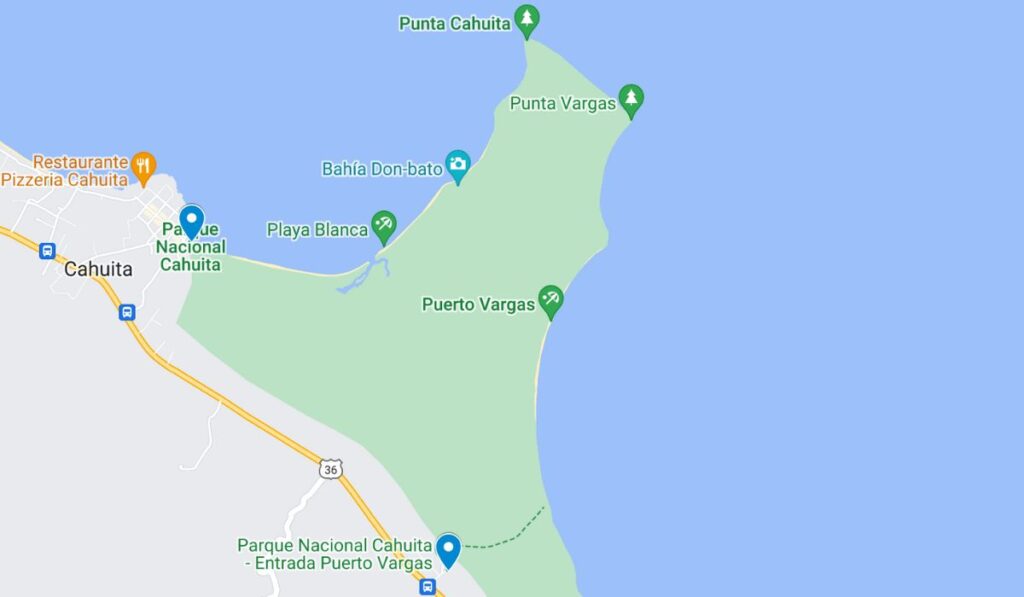
There are two ranger stations which double as entrances to Cahuita National Park. The first is called Kelly Creek Station on Playa Blanca. This is the main entrance to the park and is located in downtown Cahuita.
This second entrance is called Puerto Vargas Station. This is located on the main road between Cahuita and Puerto Viejo.
There is one main trail in the park which runs through the jungle parallel to the coastline between the two entrances.
Both entrances have a few pros and cons.
We typically enter from downtown Cahuita because it is the most easily accessible entrance from the town.
However, if you are staying in Puerto Viejo you might opt to enter at the Puerto Vargas entrance for easier accessibility.
If you are feeling ambitious you can hike from one entrance to the other and then take a taxi or public bus back to the entrance you started at.
Opening Hours
Both park entrances are open daily from 8 am until 4 pm.
Directions
Cahuita National Park is located in the town of Cahuita in the Limón Province. It is located on the Caribbean Coast just north of the town of Puerto Viejo.
As I mentioned above, there are two national park entrances. Let’s first go through how to get to this area from San Jose. Then I will explain how to get to each entrance.
Getting Here by Rental Car from San José
Renting a car and driving to Cahuita yourself is a great option if you plan to explore other areas after. We like having a rental car for the flexibility it allows us in our travel plans.
The drive from the San Jose area is a bit stressful at first because you will have to drive through the outskirts of the city. We suggest avoiding this during rush hour because it can be a bit crazy.
Once through the city, you will continue your drive by going through Braulio Carrillo National Park. This part of the drive has a bit of a Jurassic Park feel with lush jungles and foggy skies. It is almost always drizzling with some rain here.
After driving through the national park you will continue on the main road until you get to the coast. Along the way, you will see plenty of banana and pineapple plantations. As you get closer to the coast, the traffic will pick up with large trucks. This is because Limon is the main export town for these fruits heading to the US and Europe.
Once you hit Limon you will turn right and head south down the coast until you get to Cahuita. This part of the drive is beautiful and calm.
In total, the drive will take about 4 hours depending on traffic.
Just be warned, there is a police checkpoint a few miles before you arrive in the village of Cahuita. They may ask for the passports of everyone in the car. It is good to have them easily accessible so you don’t have to dig through your bags.
This checkpoint is here to monitor who is coming and going from the country. The Panama border is not too far south of Cahuita.
If you would like to drive to Cahuita and enter at the Kelly Creek entrance: Follow signs for Cahuita town and turn into the downtown area. Just continue straight until you hit the main downtown area. The national park will be on your right.
If you would like to go the the Puerto Vargas Entrance: Continue on the main road until you are just south of Cahuita. There is a small road with the national park entrance located on the left.
Here are both entrance points on a map for you
If you would like to drive, you can use our 10% discount with our favorite rental car company, Adobe.
This discount also includes other perks like a free second driver, discounts GPS, and more.
↪ GET TO 10% OFF YOUR CAR RENTAL IN COSTA RICA!
By Public Bus from San Jose
It is not the most comfortable, but there is a public bus that runs to and from San Jose and Cahuita multiple times a day. You will want to take the bus route that goes towards Puerto Viejo.
This bus leaves from the MEPE bus terminal in downtown San Jose and will drop you off at the Cahuita bus terminal. This terminal is located just outside of the downtown area. It will take you about seven minutes to walk to the Kelly Creek Park entrance.
Alternatively, you can ask the bus driver to stop at the corner of the road for the entrance to Puerto Vargas Ranger station. The bus will go right by here on the main street on the way to Puerto Viejo.
By Public Bus from Puerto Viejo
There is a bus that goes from Puerto Viejo past the Puerto Vargas station about once an hour. Ask at your hotel for info on an updated bus schedule.
Things to Note
– It may look close on a map, but you can not walk from downtown Puerto Viejo to the Puerto Vargas entrance. It is actually about 8 miles away. Plus, there are no sidewalks.
– If you would like to visit as a shore day experience from the Puerto Limon Cruise Terminal, your best option is to take a day tour with transportation included. We have suggestions for that further into this post.
Parking
If you opt to drive to the national park here are your parking options.
Playa Blanca Entrance (Downtown Cahuita)
There is a paid-for parking lot located next to the downtown Cahuita entrance. It costs about 3,000 colones. If you opt to park here, ask for the price before parking.
This lot has almost all negative reviews on Google. The main complaint is the price is always different and that there was nobody actually watching cars.
If you are staying in downtown Cahuita, it is probably best to just walk to the park entrance. The town is very walkable.
If you end up parking at the lot, make sure not to leave any valuables in the vehicle.
Puerto Vargas Entrance
There is an official national park parking lot at the Puerta Vargas entrance. You do not need to pay extra for this lot. It is included in the admission fee.
Again, don’t leave anything of value in your vehicle if you opt to park here.
Admission
From the Kelly Creek Ranger Station: From this main entrance admission is on a donation basis. You can give what you feel comfortable with. Just note that this needs to be given in cash (US dollars or colones).
From the Puerto Vargas Ranger Station: Admission is $5.65 for foreign adults and children. For Costa Rican residents the entrance fee is ¢1,130 for adults and ¢565 for children.
Just note that all national parks in Costa Rica are in the process of going cashless. I believe that this needs to be paid with credit card, but they might still accept cash in colones or US dollars.
Facilities
Here are all the park facilities you will find here.
From the Kelly Creek/ Playa Blanca Entrance in Downtown Cahuita
– There are picnic tables for guests to use that run along Playa Blanca (the main beach in the park). You could bring a lunch and your bathing suit and spend the whole day here.
– There is a basic restroom located just next to the main entrance of the park with changing stations. However, they are super basic and I don’t know if I would really want to get changed in them.
– There is a drinking water station. However, I suggest bringing bottled water instead. You never know how your stomach will react to the tap water here if you aren’t used to it.
From the Puerto Vargas Sector Entrance
– There is a parking lot at the entrance.
- At the beach, there are bathroom facilities, showers, picnic tables, and potable water.
What to Bring
Dry bag backpack: Having a day back that doubles as a dry bag is somewhat of a necessity in Costa Rica. We bought this dry bag backpack a few years ago and it is a game-changer. Keep your stuff dry on the beach or when a rainstorm rolls in.
Sunblock: We suggest SPF 50+ that is reef-safe (if you plan to swim)
Bug spray: You likely won’t have many issues with the bugs, but if it is rainy they might come out.
Full water bottles: There are two tap water drinking stations in the park. However, I don’t know if you should drink from them. There is a small grocery store just before the park entrance on the Cahuita side. They sell water bottles, Gatorade, juice etc. We like Lifestraw waterbottles for Costa Rica. If you need to fill up from the tap, these bottles filter out bacteria, parasites, and microplastics.
Snacks: If you plan to spend a lot of time here you might even opt to bring a lunch to enjoy at the picnic tables
A microfiber towel: For if you plan to swim or want to sit on the beach. We recommend microfiber towels because they fold up small for your luggage and dry quickly.
Pocket binoculars: These pocket binoculars are great for seeing all those monkeys and sloths hiding up in the trees
Rain Jacket: This somewhat depends on your personal preference. I typically find it way too hot and humid here during a rain to even think about putting a rain jacket on.
What to Wear
Sunglasses: Because….sun
Lightweight UV Blocking Shirt
Breathable Shorts or Pants
A Sun-Blocking Hat: We have this one from Colombia and love it
Bathing Suit: You could opt to bring this instead of wearing it. There are bathrooms at the entrance. However, it is much easier in my opinion to just wear your bathing suit under your clothes.
KEEN Hiking Sandals: These are great here because there are a couple of river crossings. While everyone else is taking their sneakers off to walk through the water and then trying to rub all the sand off their feet before putting their shoes back on, you can just stroll on through the water and continue your walk.
Amount of Time You’ll Need
We usually spend about 3 to 4 hours here. However, we typically only walk about half way before we get too overheated and opt to turn around.
If you opt to walk the entire trail from one entrance to the other and relax on the beaches, you could easily spend a full day here.
Just bring a ton of drinking water if you plan to do that!
The Cahuita National Park Hike

Here is a faded Cahuita National Park map to give you a bit of perspective of the trails.
The Cahuita National Park hiking trail is one trail that runs from the Playa Blanca entrance in downtown Cahuita to the Playa Vargas ranger station located between Cahuita and Puerto Viejo.
This is a jungle trail that runs parallel to the beach. It is great because you can enjoy the lush rainforest filled with tons of wildlife. But, there are plenty of opportunities to pop out onto the white sand beach lined with palm trees.
In total, this trail spans approximately 5.2 miles (8.3 km). The downside of hiking the entire trail is that you will then likely need to get back to the entrance you started at (or hike the entire way back).
When hiking at the Cahuita National Park most people opt to only hike about halfway and then turn around. This gives you a taste of the national park but keeps you from having to get transportation back to the entrance you started at.
The hike is nice because it is relatively flat the entire way with well-maintained trails and wooden boardwalks. I would say anyone in somewhat decent physical condition should be fine with this hike. The most strenuous aspect (in my opinion) is the humidity. It is so easy to get overheated or dehydrated here.
There are two river crossings that you will have to make. They are both about two miles into the walk (if coming from downtown Cahuita). The water level really depends on the tides and the season, but we have never experienced it more than knee-high and usually, it is much lower.
Wildlife at Cahuita National Park
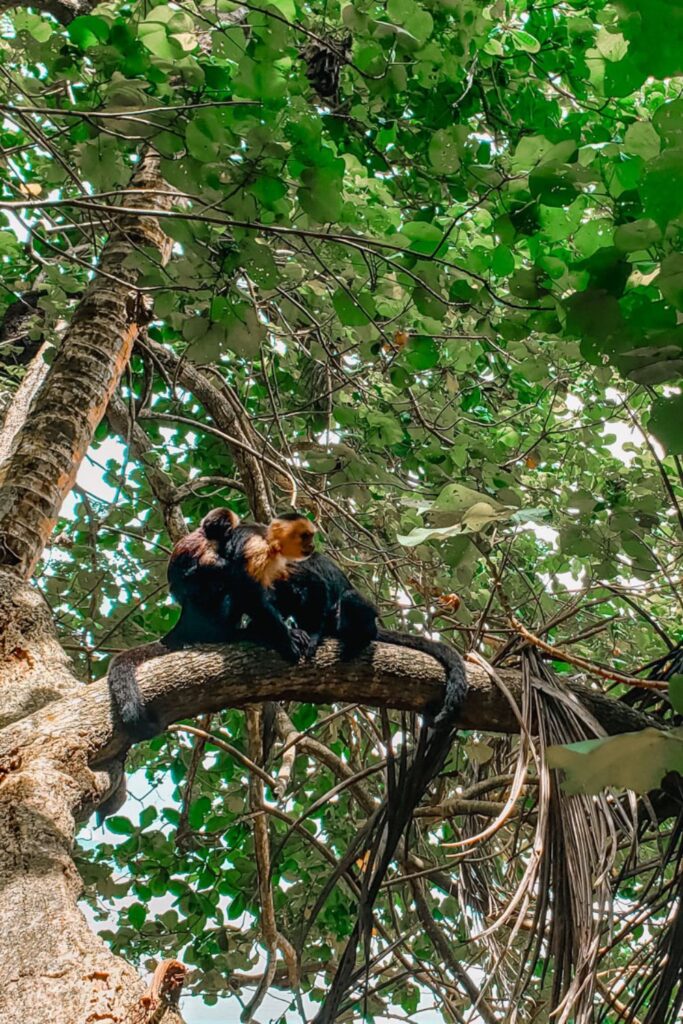
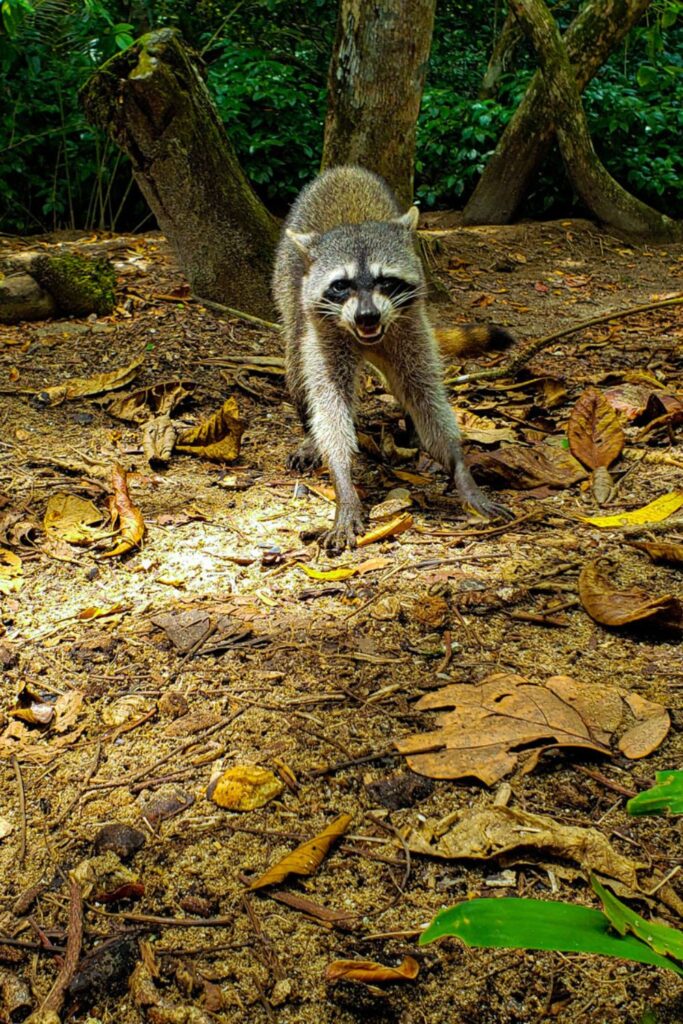
There is a variety of wildlife in the national park. On land, we’ve seen sloths, howler monkeys, white-faced monkeys, pit vipers, colored crabs, lizards, white-nosed coatis, raccoons, and more.
One time we also saw a Fer-de-lance on a tree.
Yes, I completely freaked out and didn’t leave the path or touch anything for the rest of the day. Those snakes are my number one fear in Costa Rica.
Luckily the snake was just chilling on a tree. We would have never even seen it if a guide hadn’t pointed it out.
So, with so much wildlife including poisonous critters that could potentially kill you, it is best to always stay on the paths and don’t touch anything. I’m talking, don’t use any trees to support yourself while walking.
Do You Have Travel Insurance?
Don’t let unexpected medical expenses or trip interruptions overshadow your dream Costa Rican vacation.
Secure your worry-free Costa Rican adventure with Heymondo travel insurance
Also, if you are wondering if you will spot wildlife, most likely yes you will. You can increase your chances of seeing animals by hiring a local guide at the main entrance. We will get more into that further in this post.
Besides lush rainforest, Cahuita National Park also consists of 600 acres of coral reefs. Here you can see over 120 species of fish, molusks, crustaceans, and apparently even some orcas occasionally.
The park protects nesting ground for sea turtles as well.
If you want to have some fun you can have a wildlife competition. This is something Thomas and I always do (because we are both competitive to the max). Whenever we spot a new animal that we hadn’t seen yet, the person who spotted it first gets a point. At the end of our walk, the loser has to buy lunch.
Thomas always wins….
The National Park Beaches
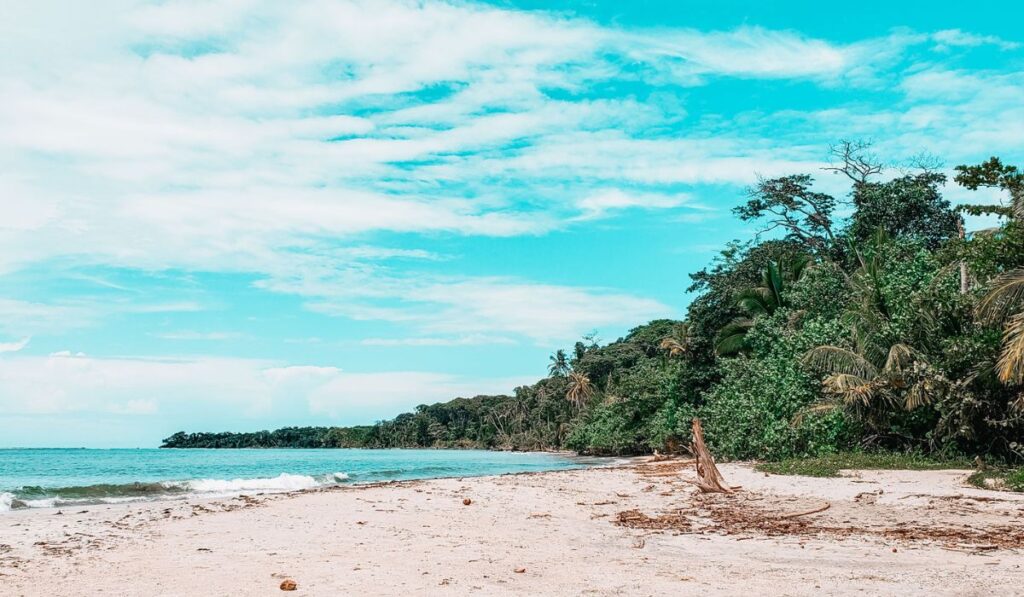
The trail through the park runs parallel to the coastline throughout the entire hike. You can pop out onto the beach whenever you want.
The nicest (but most popular) beach is Playa Blanca. This is the white sand beach that you will walk next to if you enter the park in downtown Cahuita.
There are picnic tables in the woods next to this beach. Many local families will come here for beach days with picnic lunches.
For a more peaceful experience keep hiking to Punta Cahuita and Punta Vargas. These are much smaller beaches. During high tide the amount of visible beach is somewhat limited.
The largest coral reef is located of off these points. However, you are not allowed to snorkel here on your own. You can swim, but to snorkel you are supposed to go with a guide.
If you plan to hike all the way to the Puerto Vargas entrance (or if you start at this entrance) you will pass Puerto Vargas Beach. This beach consists of a nice long stretch of coastline.
As I mentioned above, there is also a park facility here with restrooms, showers, picnic tables, and a drinking water station (I wouldn’t suggest drinking the water here unless you really have to).
Note: Please be careful when swimming at any of the beaches. Some have signs warning you, but there are rip currents. It is best to only walk in unless you are with a guide who can point out safe swimming areas.
Snorkeling in the Park
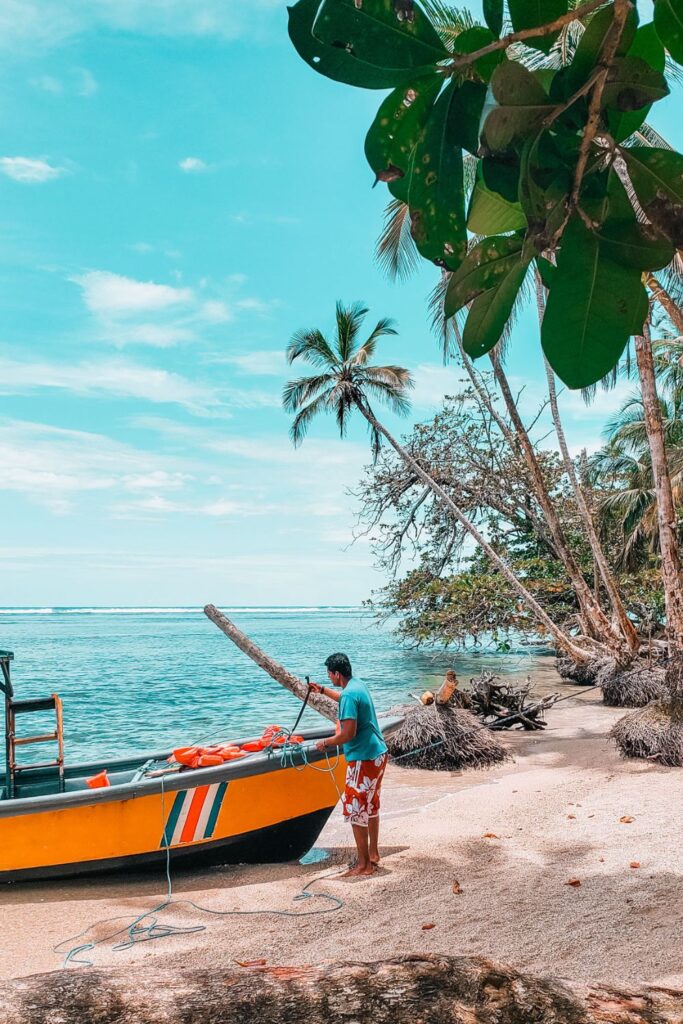
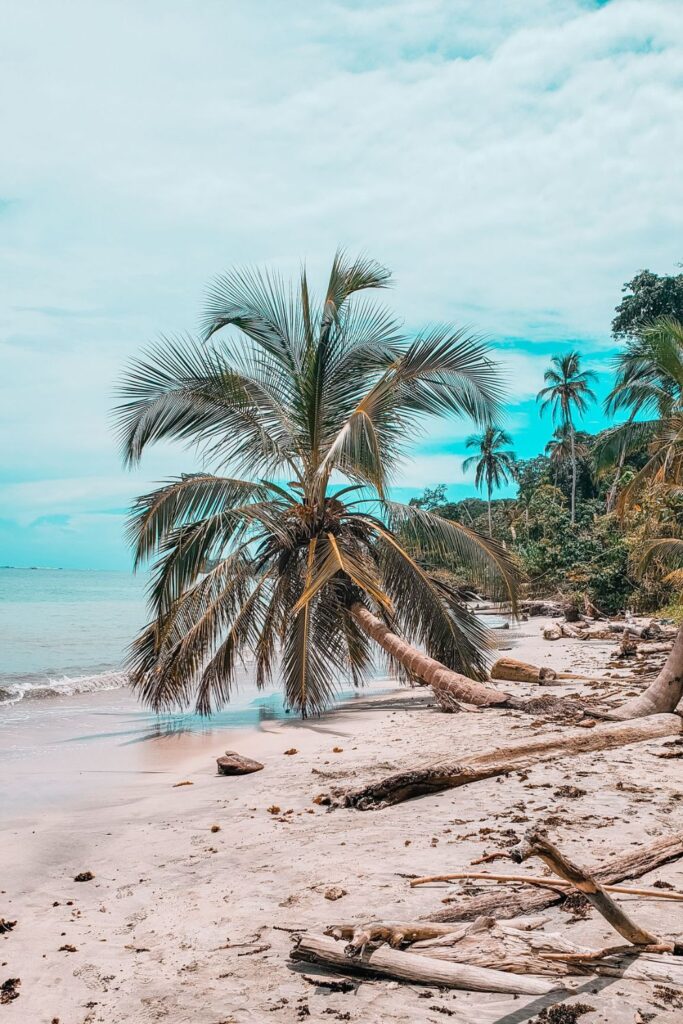
The Cahuita National Park is the perfect place to take a snorkeling tour.
The park is home to a vast area of ocean including over 600-acres of reefs with over 30 kinds of coral. This reef is one of the largest living coral reefs.
It is also filled with over 240 diverse species of marine life including tropical fish, mollusks, reef sharks, and nurse sharks.
Snorkel Tour from Puerto Viejo
⭐️ RATING: 5/5 Stars on Viator | ⏳ TOUR LENGTH: 9 hours | ✅ Book it!
This is a full-day tour from Puerto Viejo that goes to 2 snorkeling locations.
It also includes a 1.5 guided hike through the national park, breakfast, a visit to the sloth sanctuary, a canoe ride, and transportation.
I think it is the perfect way to combine a bunch of amazing things in one full day.
⤷ Check Availability and Book Your Snorkel Tour from Puerto Viejo 🤿
Hiring a Guide at the Park Entrance
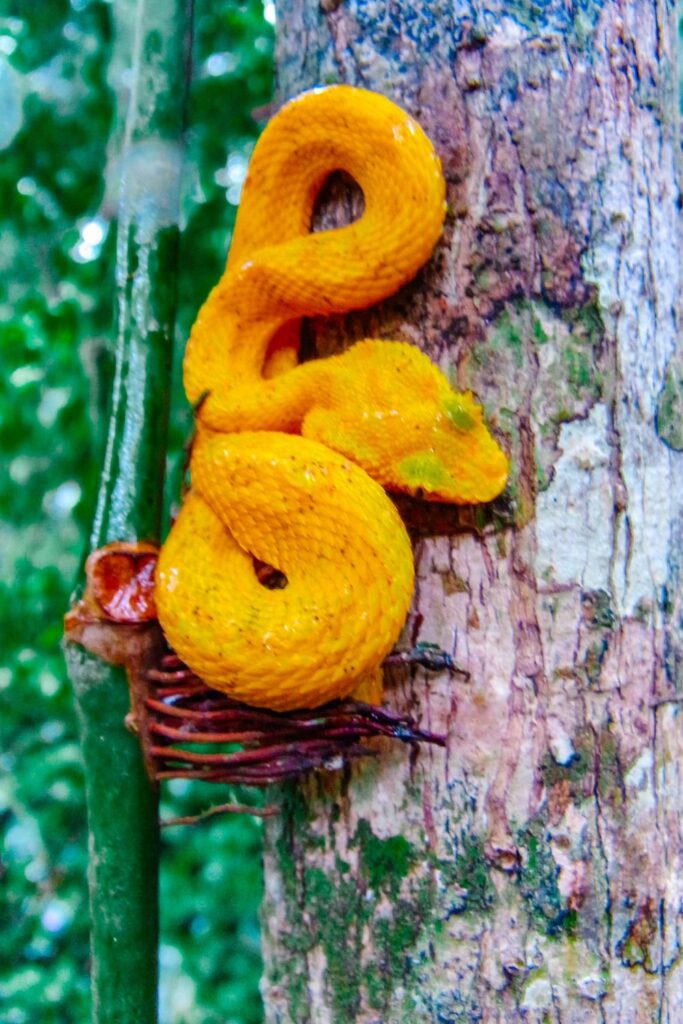
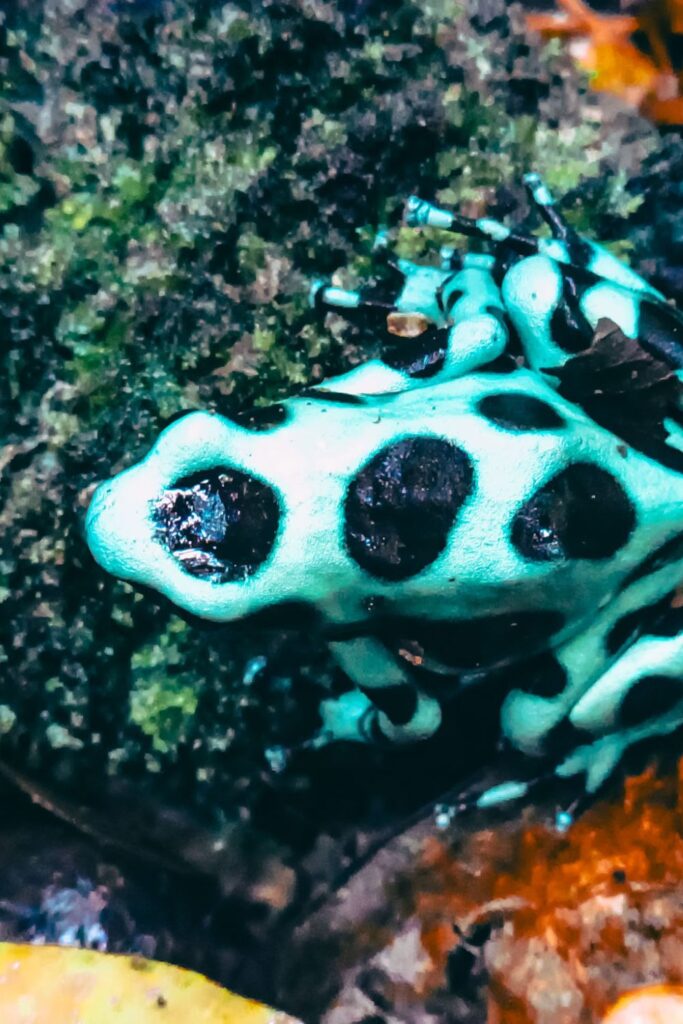
Before you pay for your admission into the park, you will notice some guides standing at the entrance. They will likely ask you if you would like to take a tour.
I suggest deciding with your travel buddies ahead of time if you would like a guide and what you are willing to pay per person. That way you can easily say yes or no to the offer from the guides.
In the past, we have paid about $25 a person for a guide. This price will go down if you have a bigger group.
Feel free to try and negotiate. They might decline your offer, but it doesn’t hurt to politely try.
Just keep in mind that Costa Ricans don’t like confrontation. If they don’t agree to your rate they might just say “no” rather than engage in a negotiation.
We have hired a guide a few times and recommend it if it is your first time in the park. It can be really difficult to spot wildlife in the thick jungle along the hiking trail, but the guides seem to know exactly where to look.
The tour guides also carry big telescopic lenses which are great for viewing the animals up close even when they are far up in the trees. They are also typically super knowledgeable on the flora and fauna in the park and can give you very detailed descriptions.
Most guided tours will last about an hour. This is perfect because, as mentioned above, most wildlife is located within the first few miles. After an hour, the guide will leave and let you continue your walk on your own.
If you opt not to hire a guide, we suggest that you at least bring some binoculars with you. Thomas is the binocular lover over here and he recommends either these binoculars or these binoculars.
The first set is great because you can easily fit them in your pocket or backpack, but the zoom is not as good. The second set is much larger but has a great zoom and an attachment for your phone so you can get a close-up picture.
Guided Tours with Transportation
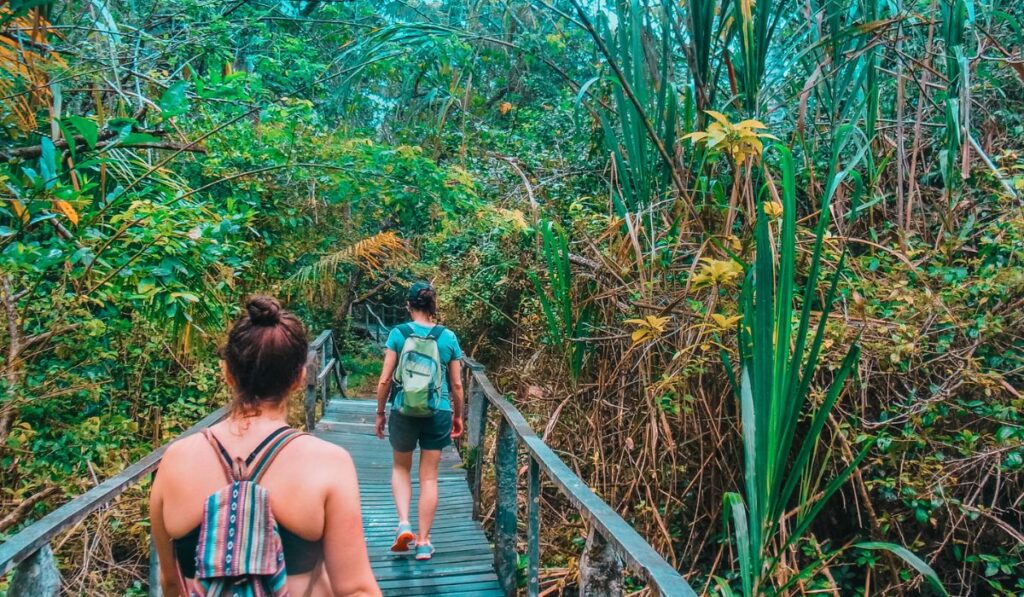
If you will not have a rental car you can opt to take a guided tour with transportation and other fun activities included.
There are tours that depart from the cruise terminal at Puerto Limon for all you cruise ship passengers as well as tours that depart from Puerto Viejo.
Here are our top choices.
Full-Day Tour to Cahuita National Park from Puerto Limon
If you will be arriving on the Caribbean Coast on a cruise and docking at Puerto Limon, this tour is for you.
This is a full day tour (6 to 8 hours) that departs and brings you back to the cruise terminal.
You will get to:
- Enjoy a boat ride through the lush Tortuguero Canals and see wildlife
- Tour a banana farm to learn more about this important industry
- Take a guided nature walk through Cahuita National Park
Check Availability and Book This Full-Day Tour
Cahuita National Park Tour and Water Experience in Puerto Viejo
This tour includes transportation from Puerto Viejo area hotels. On this fun-filled adventure, you will enjoy a guided tour with an experienced guide through Cahuita National Park.
After your hike, your group will also have the chance to visit a beautiful waterfall before returning to Puerto Viejo.
Check Rates and Availability for this Tour from Puerto Viejo
Note: If you have a rental car or are staying in Cahuita and can walk to the national park entrance, this will by far be the most affordable way to visit. You can then hire a guide at the entrance.
History of the National Park
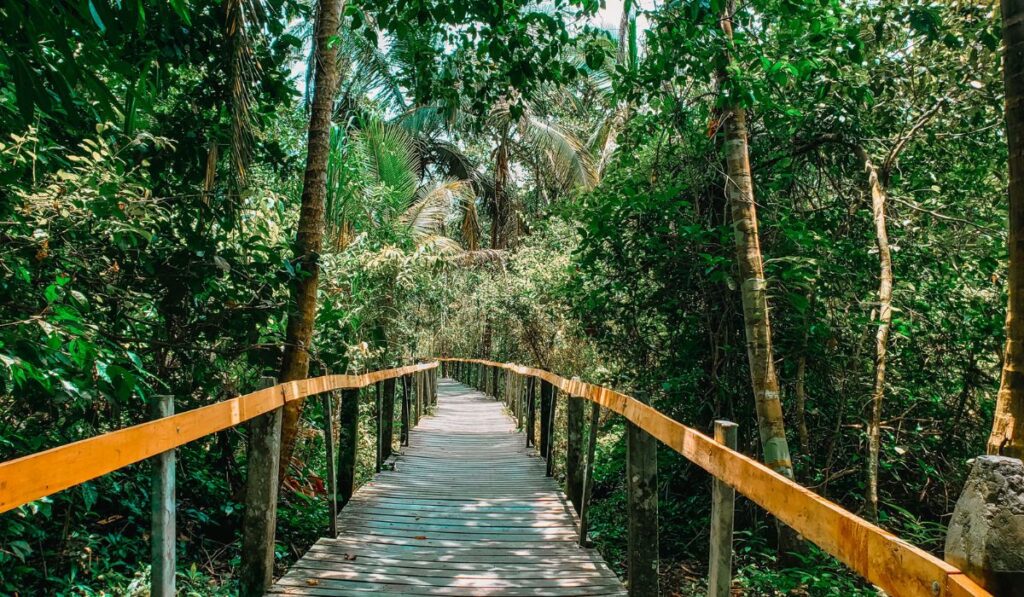
The national park used to be private land that was used for fishing and cacao crops until it was converted into a protected national park in 1978.
In total, the park stretches 2,732 acres of land and 55,200 acres of marine area.
The Cahuita National Park was established as a way of protecting the 600 acres of coral reefs that run along the tip of the park.
Cahuita and the rest of the Caribbean coast have a different vibe than the rest of the country. This area was heavily influenced by settlers from Africa and Jamaica.
We definitely suggest trying some traditional Caribbean food here. I think it is delicious!
Best Time of Year to Visit
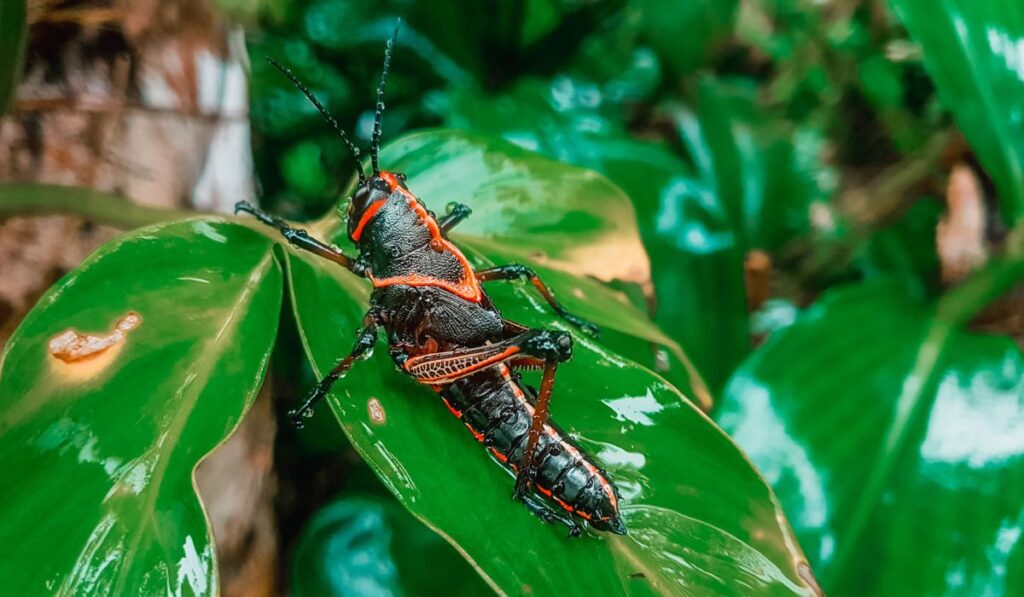
The Caribbean Coast of Costa Rica has the opposite rainy and dry season to the Pacific Coast.
If you would like completely dry weather, August and September are the best time to visit.
However, we have hiked here at all times of the and it has always been enjoyable. Even if it is raining, it is still warm out.
Plus, the jungle just looks so lush and vivid during rainy season.
As far as best time of day, we suggest arriving when the park opens at 8am. This will allow you to enjoy the trails before it fills up with other tourists hiking and local families coming to enjoy the beach.
Is It Worth a Visit?
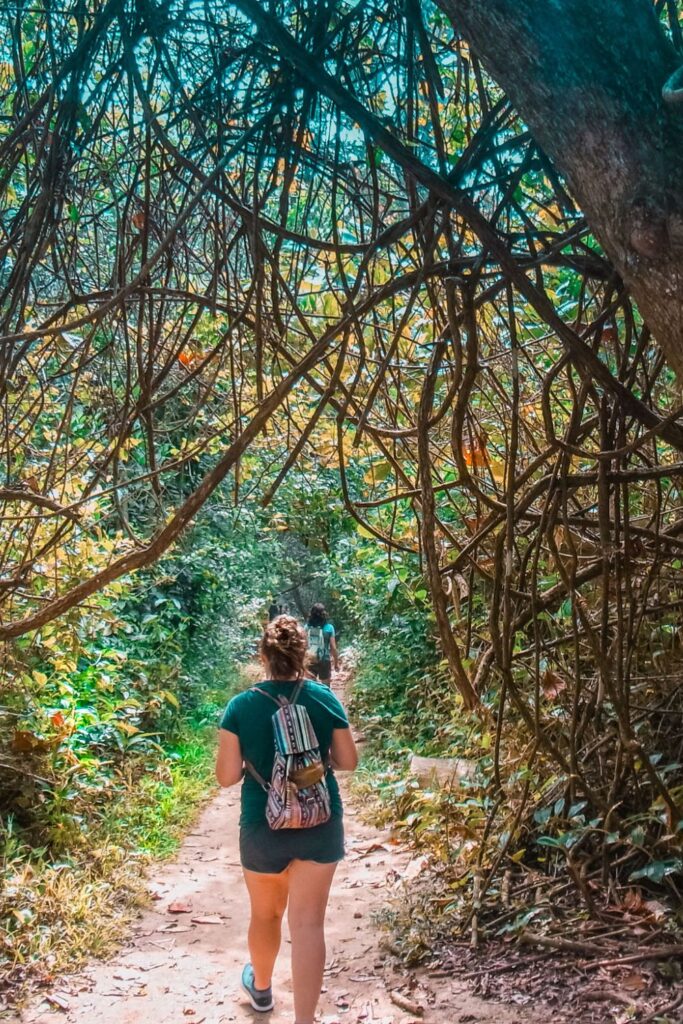

We think yes, Cahuita National Park is a great place and definitely worth a visit.
It is the perfect national park in our opinion.
We love the mix of gorgeous beaches, tropical rainforests, wildlife, and coral reef access. You really can’t beat it!
However, we don’t think it is worth it to make a trip to the Caribbean Coast just to visit the park.
It will likely end up being the highlight of your Caribbean Coast experience, but we suggest spending a few days in this area to really make the most of it.
Nearby Restaurants
Our favorite restaurants in Cahuita are:
For breakfast, before you enter the park there is a place called Kawe right near the entrance. The food isn’t amazing and the restaurant is very rustic, but it is affordable and will fuel you up with some local food for your hike. Go for some gallo pinto and fresh blended fruit juice.
Hotels Near the National Park
Here are our favorite hotels in Cahuita for all budgets.
$$$
Topos Tree House
$$
Hotel El Encanto
$
Cabinas Nirvana
Cabinas Palmer Makanda
Cabinas Tito
Other Fun Things to Do Nearby
Cahuita is a small town that doesn’t have a ton to do. But, I think that contributes to its charm. For more action, head south to Puerto Viejo.
Our favorite things to do in Cahuita are:
Watch the Sunrise
The sun rises year-round between 5:15 and 5:45 am. Yea, I know, it’s early! However, I feel like nothing beats starting your day watching the sunset from the beach. Something about getting up early and watching the world wake up really sets a nice tone to the day.
Relax on the Beach
We think that the beaches in Cahuita National Park are the nicest beaches in the town of Cahuita. However, you can also check out Playa Negro to the north side of town.
Keep in mind that all beaches in Costa Rica need to have public access by law. That means all of the Caribbean Coast is yours for exploring.
Visit the Sloth Sanctuary
On the main road just north of Cahuita is a sloth sanctuary. This facility helps rehabilitate sloths that have been injured or have previously been kept as pets.
People have mixed feelings about this facility, so you will need to decide for yourself if this is something you feel comfortable supporting and visiting. Some people feel that the Slith Sanctuary is keeping the sloths in captivity for profit under the pretense that they animals need to be kept there and can’t be re-released into the wild.
However, others belive the facility is helping animals that would never have a chance if they were just released into the wild.
You can check out there website and plan your visit here.
Conclusion: Cahuita National Park
In conclusion, Cahuita National Park is an amazing place to visit to see an abundance of land and marine wildlife, relax on beautiful beaches, and enjoy a diverse variety of lush rainforest flora.
If you have any questions about planning your visit to this Caribbean Coast park, don’t hesitate to ask in the comment section below. We are always happy to help you out!
You Might Also Like:
Costa Rica Travel Details: What You Need to Know
🚗 Should I rent a car in Costa Rica?
Having a rental car will give you the most flexibility when traveling in Costa Rica. This will also allow you to take fun day trips on your own.
- Save 10% Plus Other Perks with Our Adobe Rental Car Discount
- You might also consider; shared shuttle services or private transfer services
🏄🏽 How can I book things to do?
We find that Viator tends to have the most comprehensive selection of activities with secure booking and good cancellation policies.
🍍 I’m overwhelmed with planning. Can you help?
Of course! I suggest joining our Facebook group for specific questions and head to our Start Here Page to get started planning.
✈️ What is the best way to book a flight?
Usually, we have the best luck finding great prices with Skyscanner. Check for flights to both San Jose Airport (SJO) and Liberia Airport (LIR).
🛏️ What is the best way to book my Costa Rica hotels?
We highly suggest Booking.com for hotel bookings and typically use VRBO for Costa Rica vacation rentals.
🗣️What is the main language in Costa Rica?
The main language in Costa Rica is Spanish. Most people working in tourism speak at least some English.
💰 What is the currency in Costa Rica?
The currency used in Costa Rica is the Costa Rican colón (CRC). However, the US dollar is widely accepted in most tourist areas
📞 What is the best way to stay connected?
An eSIM from Airalo is the easiest way to get 4G data while traveling in Costa Rica.
🌴 Is Costa Rica safe?
Generally, Costa Rica is considered safe for tourists. However, like any travel destination, it’s best to use caution and be aware of your surroundings.
🛂 Do you need a passport to go to Costa Rica?
Yes, Costa Rica is its own country. You will need a passport to visit.

Hi! We’re Thomas (the German) and Sarah (the US-er)
We met in Virginia, moved to Germany, and since 2016 we have lived in sunny Costa Rica.
It was a spontaneous decision to move here, but it was the best decision!
Now we spend our days roaming the country to bring you the very best in Costa Rica travel here on Costa Rica Vibes.
Sarah is the writer. Thomas is the one keeping it all together.
Want the whole crazy story?

Sarah McArthur
Sarah McArthur is the co-founder and main writer of Costa Rica Vibes.
She is originally from the United States but has lived in sunny San Jose, Costa Rica since 2016.
She has traveled all over the country and now considers herself a self-proclaimed Costa Rica travel expert.
Want the whole crazy story?













